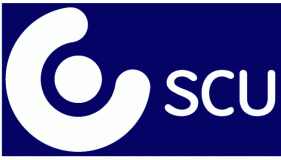Blog Archives
Innovating university outreach
Corra Boushel
Through funding from the Higher Education Funding Council for England and internal backing, the Science Communication Unit has been involved in developing an ambitious new UWE Bristol outreach programme for secondary schools in the region. We’ve worked with over 4,000 school pupils in the last 18 months, finding tardigrades, hacking robots and solving murder mysteries with science, technology, engineering and maths.
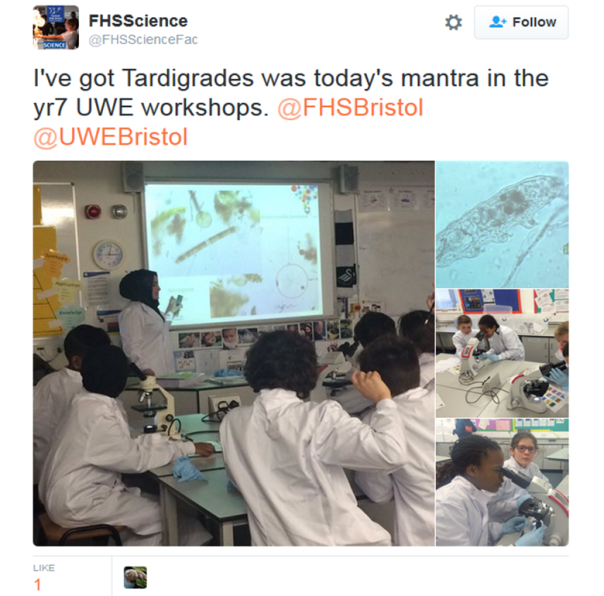
The idea behind the project is not only to engage local communities and raise pupil aspirations. Our plan is to refocus outreach within the university so that it no longer competes with student learning or research time, but instead functions to develop undergraduate skills and to showcase UWE Bristol’s cutting edge research.

The outreach activities are developed by specialists, but then led by undergraduate students and student interns, who develop confidence and skills. UWE Bristol students can use their outreach activities to count towards their UWE Futures Award, and in some degree courses we are looking at ways that outreach projects can provide credit and supplement degree modules. Researchers can use the activities to increase their research impact and share their work with internal and external audiences – getting students excited about research through explaining it to young people. Enabling students to lead outreach – including Science Communication Masters and Postgraduate Certificate students – means that the university delivers more activities, reaching more schools and giving more school pupils the chance to participate.

The brainchild of UWE Bristol staff Mandy Bancroft and John Lanham, the development stages of the project have been led by Debbie Lewis and Corra Boushel from the Faculty for Health and Applied Science and the Science Communication Unit with support from Laura Fogg Rogers. The project is now being expanded into a university-wide strategy with cross-faculty support to cover all subject areas, not only STEM.
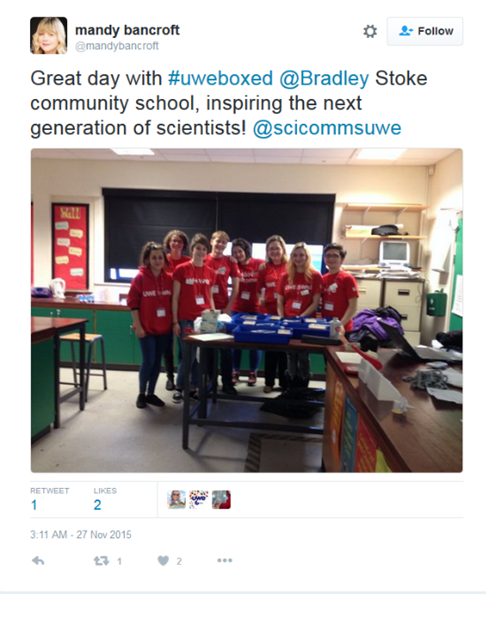 Special thanks on the project go to all of our student ambassadors and previous interns, as well as our current team of Katherine Bourne, Jack Bevan and Tay-Yibah Aziz. Katherine and Tay-Yibah are employed on the project alongside their studies in the Science Communication Unit.
Special thanks on the project go to all of our student ambassadors and previous interns, as well as our current team of Katherine Bourne, Jack Bevan and Tay-Yibah Aziz. Katherine and Tay-Yibah are employed on the project alongside their studies in the Science Communication Unit.
Baby-led, puree, Annabel Karmel and me? When science impacts on the choices we make in parenting
How we make choices as consumers, patients, parents and members of the public has, of course, long been of interest to science communicators, and topics like immunisation can continue to raise differences in perspectives, as well as media interest. A few years ago we started to think about the sometimes challenging process of weaning a baby. Ruth had recently had two young children herself, whilst completing her MSc Science Communication with us, and I’d been doing some research with parents and caregivers in community groups, so we knew weaning was a topic that was being discussed. But what about the parents who might not be out there in these social spaces, what was happening online? We asked the question ‘how do people on Mumsnet frame media coverage of weaning?’
As our starting point we considered a review of scientific evidence published in the British Medical Journal in 2011. This work, by Fewtrell and colleagues, suggested the period of exclusive breastfeeding recommended by the World Health Organisation be reduced from six months to four. Unsurprisingly the study attracted media attention, particularly in ‘quality’ newspapers like The Times, The Guardian, and especially, The Telegraph, and was frequently reported on by specialist health and science correspondents. They tended to talk about ‘risk’ but rarely contextualised that with further information on the study itself.
On Mumsnet it was clear that a vibrant community was keen to discuss the issue of weaning, and we located 112 comments that directly referred to the Fewtrell example and its media coverage. What were people most wanting to talk about? The inaccuracy of media coverage really stood out in their comments, as well as frustration that it was returning to the breast vs. bottle aspects of the debate. And the forum discussions often presented more context, nuances around the question of ‘risk’ and the details of the study itself. Of course, they had more room to do so, but it was interesting to see these types of details being discussed.
What does this tell us about science, the media and how it’s discussed online? Well it suggests that at least amongst this very small sample of Mumsnet users there is some awareness of the weaknesses that can be present in science and health reporting, but also that people often use scientific and personal information in transitionary means, embellishing some of the deficiencies of media coverage in interesting and new ways. As people become more and more reliant on social media sources for information, further work is needed on how this is supplementing and challenging our relationships with scientific and medical expertise but also how we use our social networks to support decision making. You can find out more about this work in a recent Journalism article or at:
http://eprints.uwe.ac.uk/27843/3/The_Worries_of_Weaning_paper_10_10_15%20-%20Copy.pdf
Clare Wilkinson and Ruth Knowles
Tackling the challenge of engaging with drought and frogs
SCU was well represented at the Bristol Festival of Nature (BFON) in June, with Associate Professor Emma Weitkamp manning the Drought Risk and You (DRY) stand on Saturday and MSc student Hannah Conduit showcasing her research with the Durrell Trust as part of UWE’s festival tent.
 Emma is exploring communication and engagement barriers and enablers related to drought and water scarcity within the DRY project. At BFON, Emma was interested to hear what visitors think about a set of cartoons produced as part of the project and whether these might be a tool to open conversations about water scarcity; climate change models suggest the UK will have wetter winters and drier summers, increasing the risk that we will have serious droughts. . In the southern UK, the most severe in living memory is the drought of ’76.
Emma is exploring communication and engagement barriers and enablers related to drought and water scarcity within the DRY project. At BFON, Emma was interested to hear what visitors think about a set of cartoons produced as part of the project and whether these might be a tool to open conversations about water scarcity; climate change models suggest the UK will have wetter winters and drier summers, increasing the risk that we will have serious droughts. . In the southern UK, the most severe in living memory is the drought of ’76.
Initial work within the DRY project highlights the challenges of engaging people with Drought. Unlike flooding which has immediate effects, drought has a slow onset and many not have immediate relevance to many people. Rain during BFON highlights the challenge – how do you engage people with drought when it’s raining?

Emma Weitkamp and DRY Project leader Lindsey McEwen at the DRY stand, Bristol Festival of Nature
Emma presented initial work on citizen science aspects of the DRY project at the Society for Risk Analysis meeting in Bath, 20th June, while Adam Corner, of Climate Outreach presented the project’s initial work on communication barriers.

Jeff Dawson with the project research tools
Frogs are not the cuddliest of species, so Hannah is tackling similar challenges through her research with the Durrell Trust. Amphibians have suffered a dramatic decline in numbers, and around 40% of all amphibian species are now considered to be under threat. But in a world of glamorous tigers and cuddly lemurs, it is sometimes hard for frogs to get a look in.
Hannah’s research focuses on one particular species of frog; second largest in the world and perhaps one of the most endangered. The ‘Mountain Chicken’ is aptly named for its meat; prised locally as a delicacy with taste and consistency similar to that of its feathery cousin.
With less than 100 individuals remaining in the wild and continued threat from disease, the Durrell Trust and UWE are working together to find more effective ways of communicating the plight of amphibians like the Mountain Chicken.
At BFON, Hannah and her Durrell supervisor, Jeff, along with a small group of volunteers talked with the public about the Mountain Chicken’s story, as well as showing them some of the methods used by scientists and researchers to monitor the remaining wild frogs. Scanning the stall’s microchipped frog plushies and swabbing them for a fungal disease called Chytrid proved to be the weekend’s most popular activities.

Erik Stengler, Hannah Conduit and Jeff Dawson, at the Saving the Mountain Chicken Frog stand, Bristol Festival of Nature
Research is currently ongoing for Hannah’s project, and will culminate in a handbook for use by the Mountain Chicken Recovery Programme in raising awareness and gathering interest amongst the public for the species.
Blog post written by Emma Weitkamp & Hannah Conduit
MSc Broadcasting Science students in action!
As part of our MSc in Science Communication students have the option to choose a Broadcasting Science module (‘Science on Air and On Screen’ for 2016/17 onwards). The module enables students to build their radio, TV and digital media skills by critically exploring the role of broadcast media in the communication of science. Students make an ‘as live’ radio magazine programme about science, and a short film. On many occasions these films were selected to be shown on the Big Screen on Millennium Square, Bristol, during the Festival of Nature.
The module is taught by Erik Stengler , Senior Lecturer in Science Communication and Malcolm Love , Associate Lecturer in Science Communication, and includes the use of facilities at the BBC Bristol and the production company Films@59.
You can watch the impressive short films made by our recent MSc students below.
2013
2014
2015
2016
The Science Communication Unit at UWE Bristol is renowned for its innovative and diverse range of national and international activities designed to engage the public with science. Our MSc Science Communication course is an excellent opportunity to benefit from the Unit’s expertise, resources and contacts.
As well as drawing on the academic and practical experience of staff within the Science Communication Unit, our programme gives students an opportunity to meet a range of visiting lecturers and benefit from their practical experience. This also provides an excellent networking opportunity for students interested in developing contacts among science communication practitioners. The course combines a solid theoretical background with practical skill development, and has excellent links with the sectors and industries it informs.
If you are interested in finding out more about our Science Communication Masters or Postgraduate Certificate, please visit our website.
What happens to sci comms graduates?
Lots of people are interested to find out what our Masters in Science Communication and Postgraduate Certificate in Practical Science Communication students at UWE, Bristol get up to when they leave us. As the infographic shows, it’s pretty impressive. We’re currently advertising part-bursaries to study with us in 2016/17, if you’d like more info contact Clare.Wilkinson@uwe.ac.uk
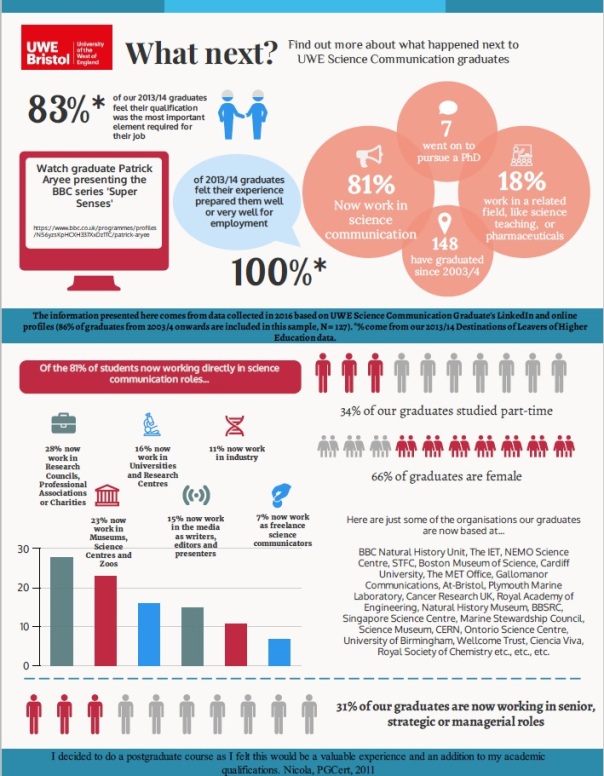
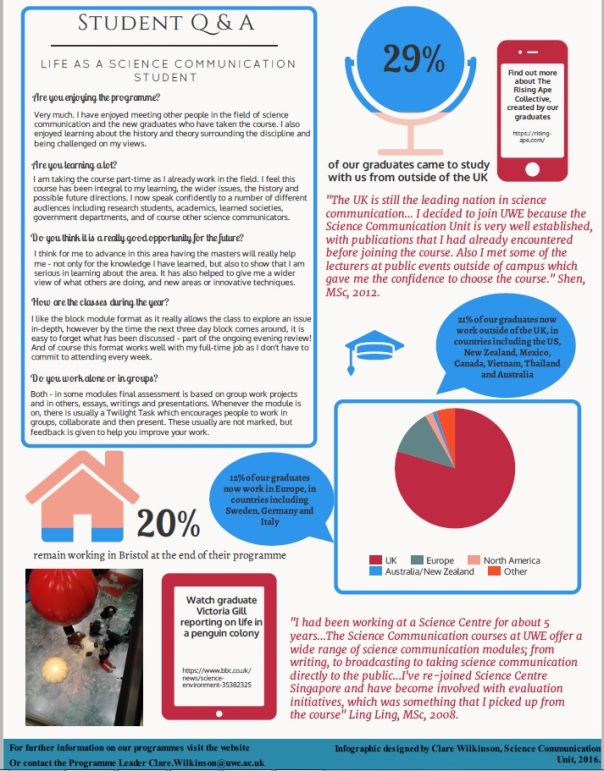
You can download a pdf of this infographic: Sci Comm UWE Graduate Destination Infographic 2016
Clare Wilkinson, the programme leader, will be presenting some of this information at next week’s PCST Annual Conference.
Behind the scenes at Bristol Museum
Text by Andy Ridgway, Senior Lecturer in Science Communication, images by Marta Palau Franco, euRathlon project manager.
“Artists love this kind of thing,” says Bonnie Griffin, Natural History Curator at Bristol Museum & Art Gallery. The thing in question is a scrawny-looking taxidermy pigeon that’s a victim of moth strike. The moths have stripped away the ‘feathery bits’ of its feathers, the barb, to reveal the rachis – the pointy bits in the middle.
He – or she – was introduced to students on our Masters and Postgraduate Certificate in Science Communication during our tour of the Museum’s natural history store, somewhere that’s normally off limits to members of the public. The tour was part of a day spent at the Museum to get an insight into the inner workings of a museum with a vast natural history collection.
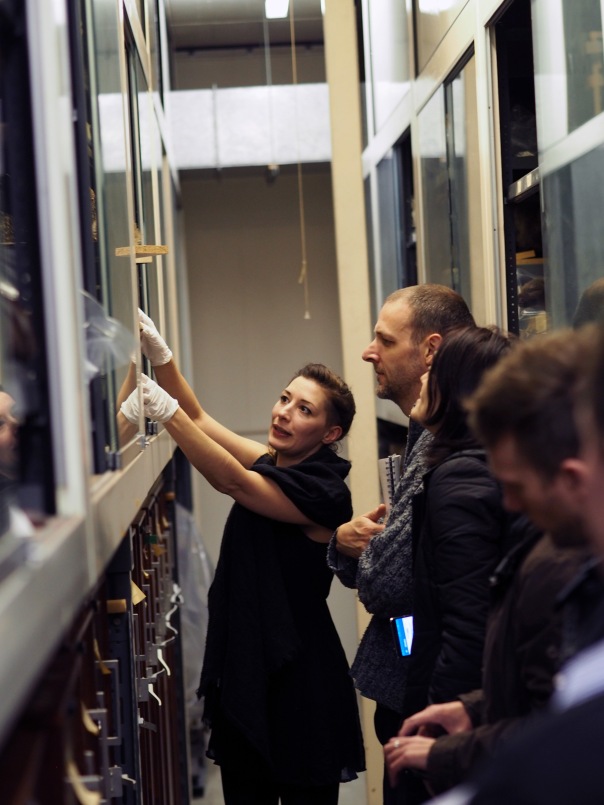
Natural History Curator Bonnie Griffin shows our MSc students some of the extraordinary taxidermy in the natural history store
The pigeon may be one of the less exotic residents of the store but it illustrates the two principle challenges of having such a huge resource; how to make use of a valuable resource when display space is at such a premium and how to stop the objects themselves being eaten or decaying in some other way.
The store has 650,000 residents – all of them dead – and this represents 90-95 per cent of Bristol Museum’s natural history collection. This means there’s only space for 5-10 per cent of the collection to be on display at any one time. It’s not an uncommon problem (and has prompted some at other institutions to consider drastic action).
But ways are being found for the store’s residents to earn their keep. So while the scrawny pigeon is making its living as an artist’s muse (the shiny tropical beetles are popular too), other residents are the object of scientific study. A humming bird, for instance, is giving us a clearer picture of what dinosaur plumage was like – apparently the way the colour and shine are created is the same as would have been the case in dinosaur feathers.

Mysterious samples make up some of the 650,000 items in the collection
It is Bristol’s history that has led to such a vast collection – its wealthy merchants of past years would pay for specimens from exotic lands to be brought to our shores. And the museum’s proximity to Bristol Zoo is another factor – several of the zoo’s inhabitants have taken up residence in the museum once they have died. Among them is Henry the orangutan, who once shared a cage with his orangutan sweetheart, Ann, at the zoo. Today, the store is taking in fewer new residents and rather than coming from far flung corners of the globe, most of it is roadkill.
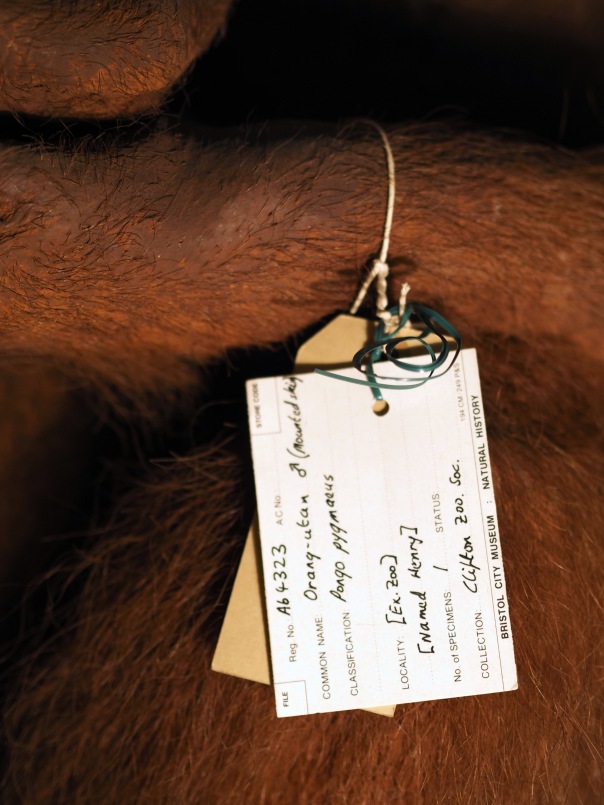
Henry the orangutan, formerly a resident of Bristol Zoo.
While moth strike is one of the threats to the natural history collection, pyrite decay (where the sulphite component of the mineral oxidises) is one of the – if not the – biggest threats to the collection in the museum’s geology store. So temperature and humidity down here are continually monitored. In the geology store we were given a guided tour by Senior Natural History Curator Dr Victoria Purewal.
Again it’s the detail known about some of the objects that helps bring them back to life. Take fossil of Pliosaurus carpenteri, that sits on one of the shelves and is the only known example of this species (it’s named after Simon Carpenter, who discovered it at Westbury clay pit in Wiltshire). Thought to be a female, it would have suffered from excruciating toothache in the final years of its life – its fossilised remains revealing signs of a tooth abscess.
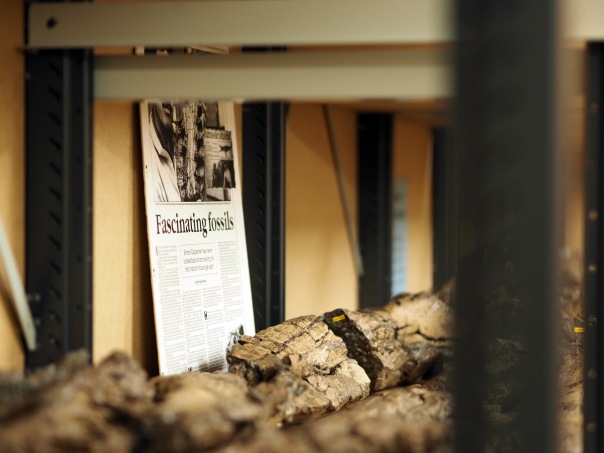
Shelves of fossils, some of them unique finds, in the Bristol Museum store.
Thanks to the staff at the museum for such a fascinating insight into their work – it was a valuable day out for our students.
Masters and beyond with the SCU
Clare Wilkinson explains some of the programmes that UWE Bristol offers in Science Communication, and how coming back to school builds towards the ‘university of life.’
This year we had around 25 new students joining us to start our MSc Science Communication programme and Postgraduate Certificate in Practical Science Communication.
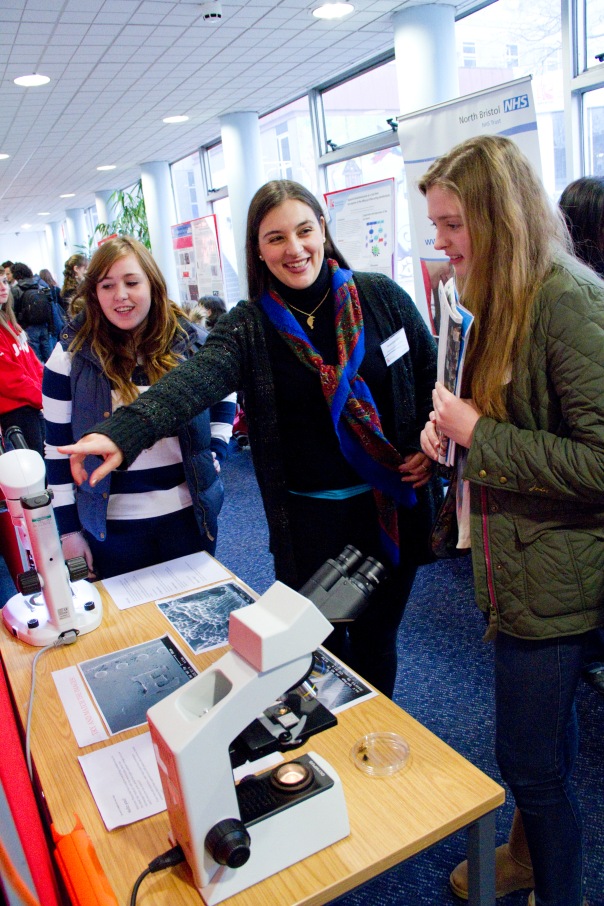
MSc student discusses a project during a UWE open day
At postgraduate level we work with students in a number of ways. Most students join our MSc Science Communication programme, as either a full or part-time student. Running for over ten years this programme has developed an excellent reputation for its combination of theory and practice. This means it continues to attract both those who have just completed a university degree and have already made the decision that their future lies in science communication, as well as students who have been working in a related field for a while and either are looking to make a career transition or to firmly establish a more formal qualification.
Running for over ten years this programme has developed an excellent reputation for its combination of theory and practice.
We also have a smaller number of students who take our Postgraduate Certificate in Practical Science Communication. Typically students on this programme tend to be practicing researchers who have been communicating their own research alongside their ‘day job’ and are looking to develop that experience further. On similar lines we also have a number of PhD students, from a wide range of areas at UWE, who are taking one or two of our science communication modules as part of their PhD programme. It’s fantastic to see early career researchers identifying a role for communication and engagement and building this into their research from the outset.
I tend to think about the programme in three ways; as ‘back to school’, the ‘light bulb’ moment and the ‘university of life’.
Back to school
As programme leader I tend to be in touch with our new students a lot, even before they start their courses. I’ll be confirming people’s module choices, double checking they are on the right programme and often having last minute meetings to let new students, and sometimes their families, get a feel for our campus and team.
Deciding to undertake postgraduate study is a big commitment, intellectually but also from a time and financial perspective, and so it’s understandable that often our students, their partners and families can feel a little nervous about it. I vividly remember once having to explain the potential job prospects of our course to an applicant’s father. Science communication was new to him and he wanted to be 100% sure it would offer his science graduate son a potential route to his desired employment in the future. I’m also well practiced in finding the odd coloured pen or piece of paper for a restless five-year old accompanying their parent to a UWE open evening, with very little interest in the new MSc their caregiver is about to undertake.
Any fearfulness will turn to smiles. A realisation takes hold that they have found a place where everyone shares their interests.
So, whatever the age, circumstances or commitments of our new students, starting a postgraduate programme will often mean change, uncertainty and challenges. My aim is that by the first day all new students feel confident that they have made the right decision for them, so that the ‘back to school’ feeling is one they (and their families) can embrace.
The light bulb moment
The start of the programme is always really busy, and this year was no different. Amongst registration activities, introductions to the library and the practicalities of life as a UWE student we also try to fit in content about life as a science communicator, and importantly, lots of opportunities for our students to meet and talk with each other. You only need to look around the room on the first day to realise that people are feeling nervous, anticipating what they will have in common with their new peers and eyeing up those they might potentially be friends with. This brings me to the light bulb moment.
We get introductions happening straight away… ‘Tell us about yourself’, I will say to each person, ‘just some snippets about you, where you are from and why you are here’. It’s then that it starts, each person around the room expressing their passion for communicating, that they love their subject (whatever that might be – we don’t only accept only science-based students on our programme), but that they think their real strengths lie in engaging around it. And one after another, any fearfulness will turn to smiles. A realisation takes hold that they have found a place where everyone shares their interest in communicating and that this will be their home for the coming weeks, months or years.
The university of life
On the first day, we distribute module guides and assessment information, talk about the various disciplines that influence science communication, and outline the expected level of reading. It will become clear that no student can learn all that there is to know about science communication in the first days or weeks of teaching and that much, much more is to come. As one door has closed on their undergraduate studies, the possibilities at Masters level can seem endless. It can be overwhelming, but as with the start of any new project the possibilities are exciting.
If you are interested in finding out more about the UWE Bristol Science Communication Masters or Postgraduate Certificate, please go to our website.
The story behind the cameras: filming robots
In 2013, just as I was finishing my Masters in Science Communication at UWE Bristol, I was asked to help film the euRathlon robotics competition in Germany. euRathlon was inspired by the situation that officials were faced with after the nuclear accident in Fukushima in 2011. The competition challenges robotics engineers to solve the problems of dealing with an emergency scenario, pushing innovation and creativity in the robotics domain. The project is led by Prof. Alan Winfield from UWE alongside seven other partner institutions. The 2015 euRathlon competition in Piombino, Italy combined land, sea and air challenges for the robots to overcome. Our 2015 film team included three of us (Josh Hayes Davidson on graphics, Charlie Nevett on camera and myself – Tim Moxon – as producer and sound engineer), taking with us all the lessons I learned from 2013.
Filming robots, particularly complex robots designed to respond to emergency scenarios, is a daunting task. Trying to make sure that we didn’t get too technical was always going to be a problem. We had the additional issue that English was not the first language of most of the people being interviewed which really added to the challenge. Taking care and with plenty of re-shoots we managed to get round both of the problems by sticking to the golden rules: take it slow and keep it simple. This made sure that we never lost sight of what we were trying to do. Our focus was always to bring 21st century robotics into the public eye.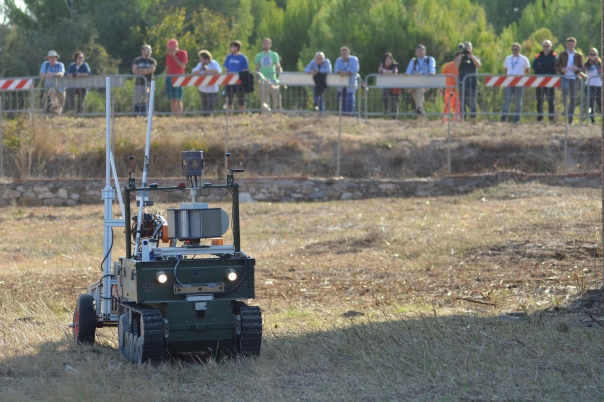
The first two days of the competition presented the individual land, sea and air trials. On site we first created two “meet the teams” films where we interviewed all 16 teams and got to know them. Luckily they were all super friendly and very cooperative which meant we got all the teams interviewed in two days. After that the real work began. The land trials were easy enough to film and get a good story line of shots as the robots were almost always visible. However the underwater robots required a bit more imagination. In the end a GoPro on a piece of drift wood got us the shots we needed.
The aerial robots had some issues too as getting long distance shots was not always easy. Fortunately Josh and Charlie were more than up to the task.
Day 3 and 4 focused on combining two domains, so land and sea or air and land etc. Day 3 went well with fantastic interviews with judges and teams helping to really give some depth to the videos. Again underwater proved to be a bit challenging but we managed, with the help of some footage given to us by the teams that they took on-board their robots. Day 4 didn’t go as well as the second half of the competition had to be cancelled due to strong winds. Wind had been an issue throughout the competition and all of our equipment required regular cleaning to keep the dust out, as well as dealing with constant wind when recording sound.
That day however you could barely stand in the open for all the dust and sand being kicked up by the wind and getting good sound for interviews was nearly impossible. We could only hope that the weather improved for the Grand Challenge.
The final days were the Grand Challenge, as much for us filming as for those competing. The timescale was starting to tighten as we only had two days to film, cut and polish the remaining two videos. With increasing pressure to produce high quality products we pulled out all the stops. Fortunately all the teams rose to the occasion and provided us with some spectacular on-board footage as well as some nice underwater diver footage. The Grand Challenge turned out to be a great success with all the teams at least competing even if they didn’t all finish the challenge.
Tim Moxon completed the UWE Bristol Masters in Science Communication in 2013.
For more information about EuRathlon please visit the project website.
Student opportunities at the Latitude Festival
One of the nice things we’re able to do from time to time is offer our Masters students work experience on a public engagement project.
For the last two years (2014 and 2015) Margarida Sardo and I have carried out an evaluation of a strand of activities sponsored by the Wellcome Trust at the annual Latitude Festival.
The Latitude Festival is a well-known and wide-ranging cultural festival, which includes comedy, music, theatre, literature, poetry, dance and more (think Glastonbury but with less mud and more writers!). The Wellcome Trust events are also hugely varied, including poetry, music and theatre performances, presentations, discussions, dialogues and interactive events.
Margarida designed the evaluation, including snapshot interviews with members of the audiences, informal feedback via comment cards, observations of events and interviews with presenters, while I led the evaluation at the festival. In both years, the students were chiefly responsible for carrying out the audience interviews and looking after the informal feedback, so it was an excellent opportunity to gain an understanding of what is involved in the evaluation of a live event as well as strengthen their communication skills.
With around 26 events taking place in half a dozen locations around the three days of the Festival, the help and support of our students was absolutely invaluable in helping to collect as much data as possible. Between them, the 2015 team observed 14 full events, persuaded 45 people to be interviewed and got 192 people to complete a comment card!
In return for students’ support, we offered a modest payment, subsistence expenses during the Festival and free transport to and from Suffolk. The students also had free tickets to the Festival, which gave them access to most of its 200 or so events. As most of the science events took place during the day, and the big comedy and music headliners were on late at night, the students got to see some really interesting stuff!
You can find our report from the 2014 Festival on the UWE repository. And the hard work of the students is also contributing to two papers that Margarida and I are currently working on.
Ann Grand and Margarida Sardo are research fellows in the Science Communication Unit.













